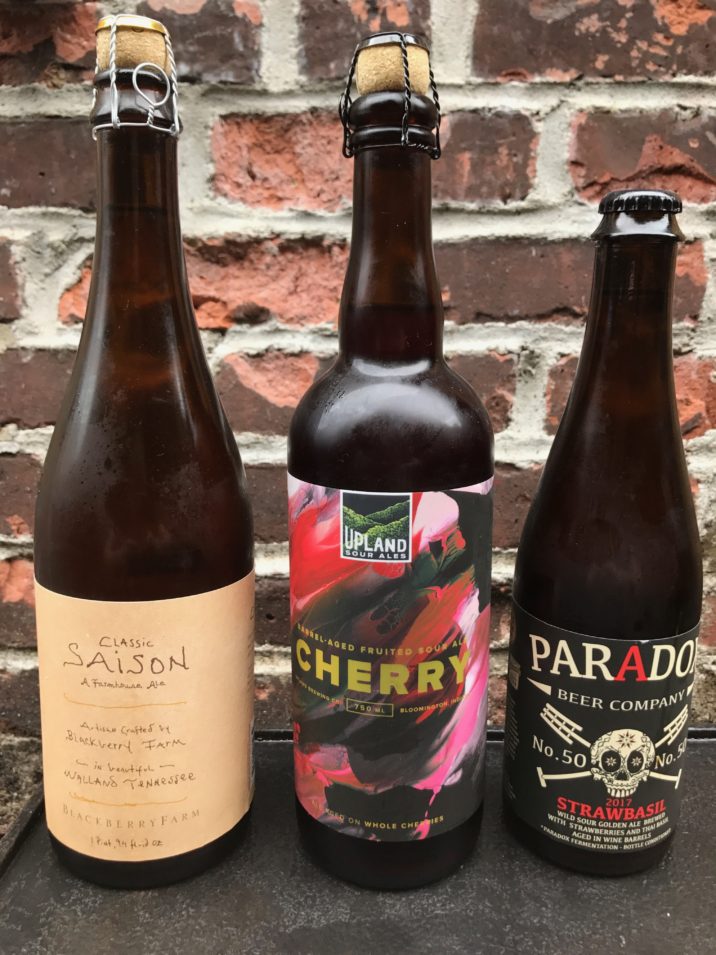If you’ve been paying close attention to the beer section at Formaggio Kitchen, you may have noticed something: it’s getting older, quite literally. More than ever, we’re able to feature beer that has been aged well beyond the time it takes to brew a standard lager or ale. Instead of weeks, many of these beers are aged years. This focus is part of an exciting trend in the world of American beer as brewers embrace traditional aging methods while continuing to experiment with ingredients and innovative techniques.
As with any of our products, we believe a little bit of knowledge and understanding about various types of beer can help our customers appreciate the flavors, aromas and textures coming from the bottle. With this in mind, this post provides information about how different applications of wood barrels can affect the resulting qualities of a beer.
Beer Meets Wood
Barrels, invented sometime around year zero, have been the standard vessel for aging beer until stainless steel came on the scene in the 1950s. While stainless steel has the advantages of being durable, predictable and easy to clean, it does not contribute chemically to the final product. Despite the widespread embrace of stainless steel in beer production, wooden barrels have always maintained a place in artisan beer production. While moderately unpredictable compared to stainless steel, wood offers two primary advantages: the organic compounds in the wood break down during aging and contribute flavors to the beer and as a porous material, wood allows microorganisms to hang out and contribute their own flavors to the beer. Classic styles like lambics depend on these factors to allow the wild yeasts and bacteria to develop and contribute their characteristic flavor profiles.
When you encounter an aged beer, there are a few terms you might come across that bear explaining.

Barrel-fermented means that wort (the liquid coming from mashed grain and water), yeast, and other bacteria undergo their primary fermentation in a wood barrel, usually oak. In this stage, yeast is breaking down wort sugars into alcohol and carbon dioxide. This process, when it occurs in the barrel, can impart a subtle oak quality to the final product.
Barrel-aged is used to describe beers stored in barrels, which have been carefully selected for the flavors they will give the beer after the aging process is complete. These barrels are often taken from liquor production operations such as those used in production of various whiskies. Bourbon barrels are a common choice, imparting caramel, vanilla, and toffee flavors. Other choices include rye barrels that lend a subtle spiciness or single malt scotch barrels that add a hint of smoke. Wine and fortified wine barrels are also having a moment; these barrels contribute cherry, blackberry or raisin notes, along with some tannins that impart a drying sensation to the palate.
Sour Beer?
Traditional sours, such as lambics, need time for the biological and chemical processes to happen--the important yeasts and bacteria for sours, like Brettanomyces and Pediococcus, only take hold after other bacteria have created hospitable conditions in the wood. Sometimes brewers rely on lactic acid to make sours without wood or aging. To me, this process yields a chemical sharpness, while wood-aged sours with naturally occurring Lactobacillus offer a more complex and balanced sour.
Many sours, whether traditional recipes or modern takes on tradition, include fruit. Fruit likely came to the aging process coincidentally, from early, pastoral breweries working with a variety of available fermentables. Conveniently, fruit offers both a fermentable sugar base as well as its own tartness. The most traditional fruits you’ll see are cherry and raspberry, but tropical fruits like guava and passion fruit are also gaining popularity. If you’re skeptical of fruit beers that are overly sweet, you’ll be pleasantly surprised by fruit sours. With almost no residual sugar, you’ll often taste the essence of fresh fruit with a tart and earthy backdrop.
Adding fruit to beer is also a wonderful example of terroir. Brewers like TRVE proudly showcase Colorado peaches in Departure of Consciousness, and Blackberry Farms features local peaches and plums blended with three different beers aged in red wine barrels.
Cheese & Wood-Aged Beer Pairings
Wood-aged beers are worthy of drinking in moments of quiet contemplation, but they are also sensational and fun partners for cheese.

Try Upland Cherry Sour with Brebis du Haut Bearn. This plays off the classic combination of cherry jam and sheep’s milk cheese; the rich tart blonde ale, aged in oak barrels, will be wonderful with the mustardy, savory spice of the Brebis.
As a way to extend summer, play on the clean, light flavor of fresh mozzarella with Paradox Strawbasil. Strawbasil is aged in wine barrels, and picks up a sour quality from the acidifying bacteria naturally found in the barrels.
What could be better than two classic farmhouse styles brought together? The barrel-fermented Blackberry Farms Classic Saison works well with Cabot Clothbound or Montgomery’s Farmhouse Cheddar. The slight bitterness and funky depth of the beer plays off the sharpness of the cheese and let fruity notes shine through.
And finally, the first beer and cheese pairing I ever fell in love with, now a Formaggio Kitchen classic: barrel-aged stout or porter with blue cheese. I recommend Bayley Hazen or Stilton. The dark chocolate flavors in a good stout will bring out the spice and nuttiness in the cheese and create a rich, creamy tasting experience.
Author Jeremy Blaustein is a supervisor, buyer, and beer lover at Formaggio Kitchen Cambridge. He recently represented the store at Beer Meets Wood, a Beeradvocate festival in Portland, Maine celebrating wood-aged beers.

